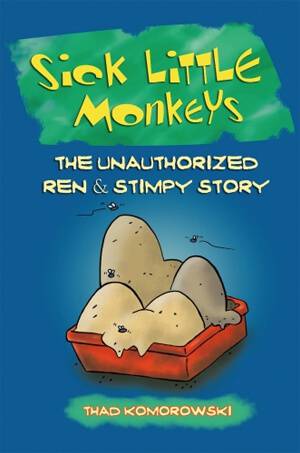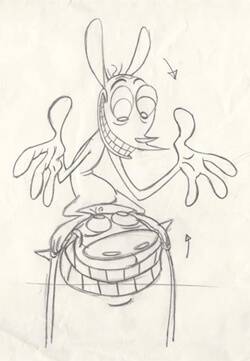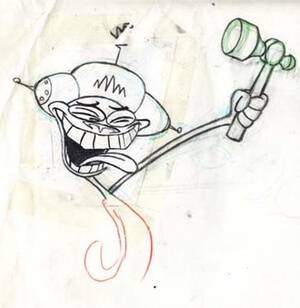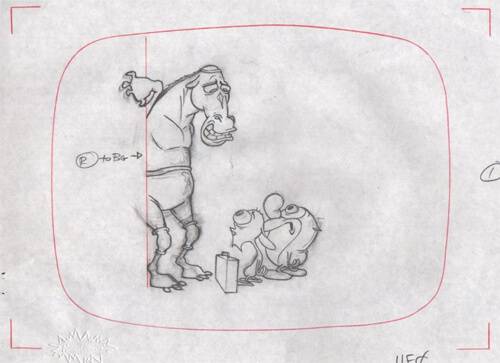‘Sick Little Monkeys’ Book Review
 One of those bizarre incongruities this reviewer has never quite been able to put his finger on is that, for all the acclaim and respect it has seemingly generated within the animation industry at large, The Ren & Stimpy Show remains to this day something of a hard sell amongst peers. Surely in a world where ‘adult’ animation – and all the caustic, violent and ribald associations such a subgenre carries – is well into its second decade of prevalence, the edge and insanity of John Kricfalusi’s cat and dog duo has become more accessible? Or perhaps the risks it took in regard to tone and storytelling remain as impenetrable to some now as it did back in the early nineties?
One of those bizarre incongruities this reviewer has never quite been able to put his finger on is that, for all the acclaim and respect it has seemingly generated within the animation industry at large, The Ren & Stimpy Show remains to this day something of a hard sell amongst peers. Surely in a world where ‘adult’ animation – and all the caustic, violent and ribald associations such a subgenre carries – is well into its second decade of prevalence, the edge and insanity of John Kricfalusi’s cat and dog duo has become more accessible? Or perhaps the risks it took in regard to tone and storytelling remain as impenetrable to some now as it did back in the early nineties?
Another possibility, one that I’d concede far more begrudgingly, is that the infamy of the show’s troubled production has, in hindsight, dwarfed its achievements; Could any show truly stand up to such legendary controversy and debate?
Well, if one show could, Ren & Stimpy would make a fair stab at doing so, scratching, clawing, shrieking and ‘hwarf’-ing all the way. After twenty-plus years, however, the truths of what really led to its downfall and demise have given way to contradictory accounts and vagueness, with few cut and dry explanations offered impartially.
Thad Komorowski’s Sick Little Monkeys: The Unauthorized Ren & Stimpy Story is perhaps the most thoroughly-researched and extensive attempt to shed real light and clarity on the matter. From the outset his approach is candid (while he relies heavily on interviews for accuracy, it is revealed before the book begins proper that Kricfalusi himself had no firsthand involvement in the book after their initial correspondence quickly devolved into sniping) and, most refreshingly, without allegiance to any party in particular. Ultimately what is confirmed through his incredibly readable interpretation of events interwoven frequently with interview snippets from those involved in all aspects of the production is what most of us knew on some level, that no one individual or group was entirely to blame. Kricfalusi isn’t messianically glorified, yet his undeniable streaks of genius and true moments of artistic strength are given the praise and acknowledgement they deserve. From his earlier work as protégé of Ralph Bakshi right through to the public persona presented to the world today via his blog, the same identifiable passion and enthusiasm – and all the risks that come with it – has stayed with him throughout.
It is hardly surprising, then, that against the mundane world of regulated TV production, said passion would lead to clashes and battles of wills. Tales familiar to most who had followed Kricfalusi’s controversial firing from his own show at the time are expanded on in ways that recontextualise many aspects of the story altogether. Most engaging of all are the elaborations on what became of the show post-Spumco, and the hugely unfortunate conflict that resulted from his absence. The low morale of those that remained during the Spumco/Games handover with the maligned (yet superbly talented) Bob Camp at the helm – along with the harassment they endured – is disheartening. Sadder still are the interpersonal fallouts and dissolutions of friendships within the artists and crew themselves. This is one of the major contributors to why Sick Little Monkeys is not just a book for fans of Ren & Stimpy – it’s a perfect case study anyone working – or aspiring to work – in TV animation can benefit from; How a show can soldier on and manage to more or less survive despite hitting every conceivable snag. Network indecision, shambolic lines of communication between studios and misguided pride are only a handful of many spanners in the works, and while Kricfalusi’s perfectionism was undoubtedly at odds with Nickelodeon’s naïveté and poor handling of content issues, his absence did not make the show better or more consistent.
The book also features insight into a number of areas that had not been fully explained, some leaning more toward the trivial for the benefit of geeks like myself (why season one looked so ropey, why the Games logo has Stimpy as a milkman, why the episode Svën Höek had two alternate soundtracks and so on), others giving more pause for thought in their extensive analyses of individual episodes. Some shows now hailed as classics of Kricfalusi’s tenure are revealed to have not been merely finished after his dismissal, but recreated more or less from scratch, while two of the show’s earlier and most visually captivating episodes (series pilot Big House Blues and game-changer Stimpy’s Invention) are broken down shot-by-shot with each lead animator credited.
In this vein it’s pleasing to see the attention paid to the efforts of some of the show’s most talented artists, directors and designers. Even with their limitations addressed, the work of Games-era talents such as Bill Wray, Chris Reccardi, Lynne Naylor, Scott Wills (all of whom went on to produce equally strong work for shows Ren & Stimpy paved the way for) et al are given long-overdue acknowledgement, and while the latter seasons of the show’s Nickelodeon run certainly fell prey to repetition and misfire, when everything fell into place they were still able to pull off some of the best television of their time. Regrettably these instances became rarer and rarer before the show petered out altogether.
John Kricfalusi’s own short-lived, adult-audience revival of the show, known as Adult Party Cartoon (The Lost Episodes on DVD) is given perhaps the most thorough and keenly-observed analysis I’ve as-yet read in the book’s penultimate chapter, matched only by a public correspondence between historian Michael Barrier and Kricfalusi himself around the time of its broadcast. Unexpectedly the accounts presented of this new incarnation’s own set of dramas seem to outshine the far more public acrimonies of the Nickelodeon fallout. It is this short run that unfortunately seems to have put a lid the Ren & Stimpy universe rather than opening it up to future possibilities, as documented in the episode guide at the end of the book. While the main body of the text never states opinion as fact, Komorowski making pains to justify and explain his findings with extensive detail and footnotes, said episode guide throws impartiality out of the window, though not unreasonably. Opinions will always differ on the strengths and weaknesses of individual episodes and a methodical listing of credits and synopses would be a little dull without the added character of his grading system.

Layout from “A Yard Too Far”
Ultimately The Ren & Stimpy Show comes across as a radical gamble that was doomed from the outset by its own audacity. It served as a springboard to a whole slew of subsequent shows that went on to far greater mainstream success in the late-nineties and beyond, perhaps through demonstrating what pitfalls to avoid by falling into them itself so frequently. Its flaws, multitudinous though they may be, contribute to its charm and its place as contemporary animation’s biggest anomaly and, simultaneously, it’s most important saviour. Kudos to Mr. Komorowski for being the one to finally write the book on it.
In conclusion: Yes sir, I like it.
Sick Little Monkeys: The Unauthorized Ren & Stimpy Story is available now from Bear Manor Media. For more information on the book and to access a wealth of rare sketches, line-tests and other Ren & Stimpy-related findings you can check out the Sick Little Monkeys Facebook page.
Items mentioned in this article:




